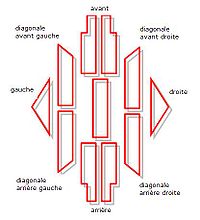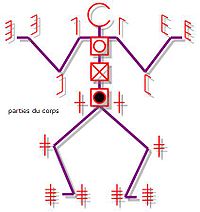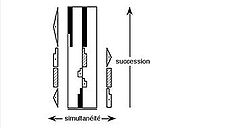- Labanotation
-
Notation Laban
La notation Laban est un système de notation du mouvement inventé en 1928 par Rudolf Laban (1879-1958). Ce système est appelé Labanotation aux États-Unis, Kinetography au Royaume-Uni et cinétographie en France.
Rudolf Laban a construit son système autour des quatre éléments essentiels constitutifs d'un mouvement : l'espace, le temps, le poids et la force.
Les signes d'écriture sont placés le long d'une portée verticale qui se lit de bas en haut. La ligne verticale centrale définit l'appui au sol. Ainsi, la plupart du temps, les appuis des pieds sont placés à gauche et à droite de la ligne centrale, déterminant le pied en mouvement.
Un même signe indique :
- la direction du mouvement (avant - arrière - gauche - droite - diagonales - sur place)
- sa hauteur (haut - bas - intermédiaire. Exemple pour les appuis : haut = sur pointe ; bas = plié ; intermédiaire = « normal »)
- sa durée (indiquée par la longueur du signe)
- la partie du corps concernée par le mouvement.
Le placement des signes sur la portée donne la simultanéité des mouvements (lecture horizontale) et leur succession (lecture verticale).
Les distances, les relations avec des partenaires ou avec des objets, le centre de gravité, la dynamique, les tours, sauts, trajets et déplacements au sol sont indiqués par des signes spécifiques.
Liens externes
- International Council of Kinetography Laban (ICKL)
- Site sur les notations Laban et Benesh
- Site du Centre national d'Écriture du Mouvement (CNEM), France
- Dance Notation Bureau (DNB), USA
- ANM Association Notation pour le Mouvement
- Portail de la danse
Catégorie : Notation du mouvement
Wikimedia Foundation. 2010.



